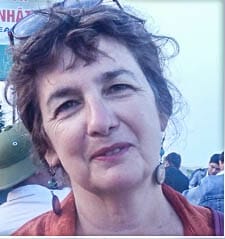Editor’s Note: Find more OVID.tv film reviews here.
We follow the camera down many a dust road to small West African hamlets. The camera is following a slave trade researcher’s multi-year quest to solve the mystery of the San Lazaro festival.
This Afro-Cuban festival of dance and song is held every December 17 in Central Cuba. From mothers to daughters, fathers to sons—rich cultural traditions have been safeguarded and nurtured through the generations of slave progeny. Truth to tell, nobody fully knows what the words mean any more, or the dance rituals.
The Cuban people who uphold these traditions are called Ganga-Longoba. The film’s narrative reminds that the life expectancy of a slave in Cuba was only seven years. Where did the songs come from?
“They are We” Captures the Emotions of First Recognition
Filmmaker and slave trade researcher Emma Christopher took recordings of these songs and dances with her on her travels crisscrossing West Africa. We see her many journeys in maps showing her travels like breadcrumb trails. We get the feel of one after another group of African villagers watching the Cuban ceremonies with interest. There are few signs of modernity in these hamlets; the main things they seem to have in common are dusty dirt roads and thatch roofs. In the penultimate stop, someone says with authority it is the Bantu people. From there the camera captures the first viewing of the Ganga-Longoba’s long lost African family, and the earthquake of recognition when they first see the San Lazaro video. It is captured by the emotional exclamation that became the film’s title—“They are we!”
It didn’t take a 23 And Me genetic study to trace this connection. Rather, it was only the recording of the San Lazaro festival to see who could decode the words. How astounding to be there at exactly the first time when African villagers sing along to the songs they know so well!
Through research the filmmaker is able to trace it to but one slave girl—Josefa. Oral traditions over 170 years and in two different continents successfully preserved culture. It truly astounds, in this writer’s view.
The film continues to show the first re-union meetings of the African villagers with their now Cuban cousins. It is not one brief encounter, but rather many moments of sharing. Both African and Afro-Cubans- are clearly moved. So are we. Many, will likely agree with this writer, that few documentaries pack as much emotional punch. If you have studied the horrors of the Middle Passage, and have come to the conclusion that survival of that holocaust itself was miraculous, this story multiplies that wonder exponentially.
This film will especially appeal to those with an interest in cultural anthropology or Black history. Given the frequency of advertisements one sees for Ancestry.com on tv—this story will likely also have broad appeal to the much wider audience interested in where we all come from.
HIGHLY RECOMMENDED
For more information visit the Ovid.tv THEY ARE WE webpage.
Nominate this for The Picture This Post BEST OF 2020???
Click Readers' Choice
Vote Securely! Vote Privately! And Make Your Vote Count-- as all voting should be!!
Click here to read more Picture This Post Review of Top Pick Documentaries and watch this video --
Picture This Post Documentary Reviews RoundUp --Our Top Picks
Images courtesy of Ovid.tv

About the Author: Amy Munice
Amy Munice is Editor-in-Chief and Co-Publisher of Picture This Post. She covers books, dance, film, theater, music, museums and travel. Prior to founding Picture This Post, Amy was a freelance writer and global PR specialist for decades—writing and ghostwriting thousands of articles and promotional communications on a wide range of technical and not-so-technical topics.









